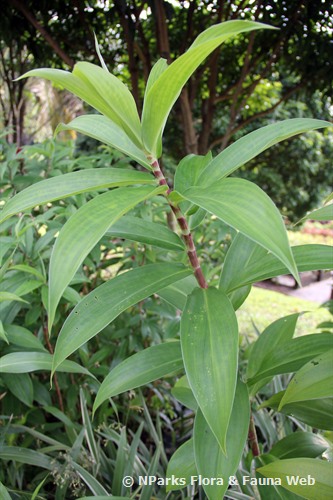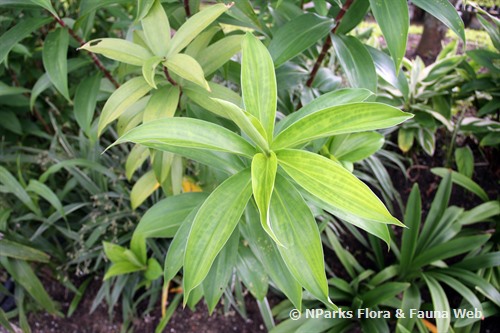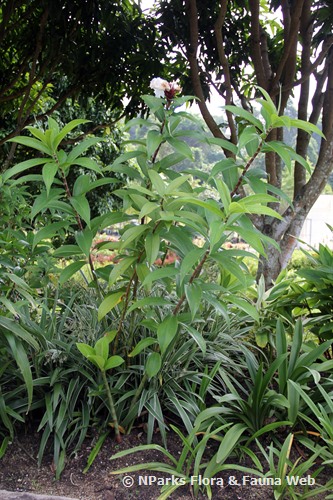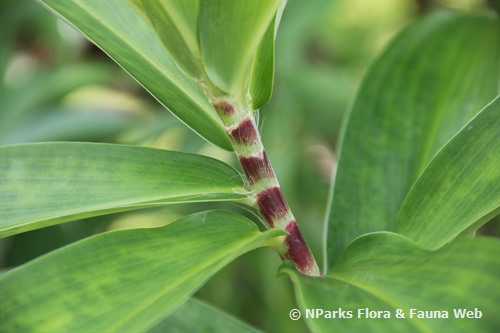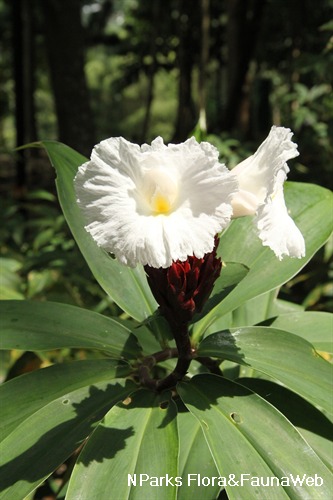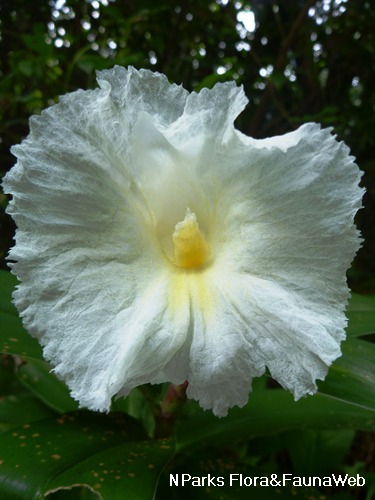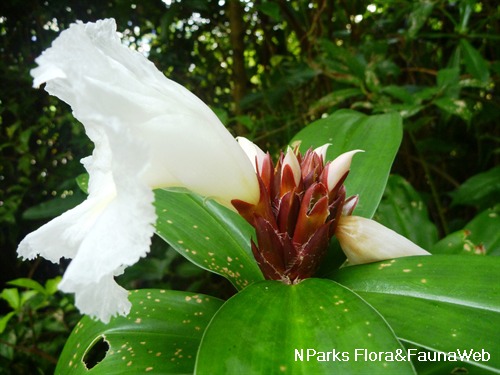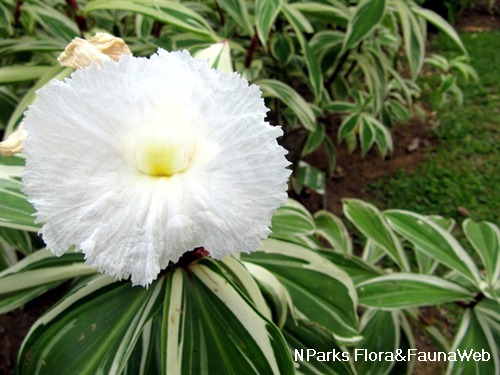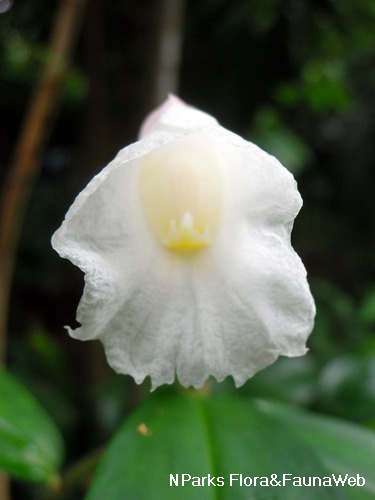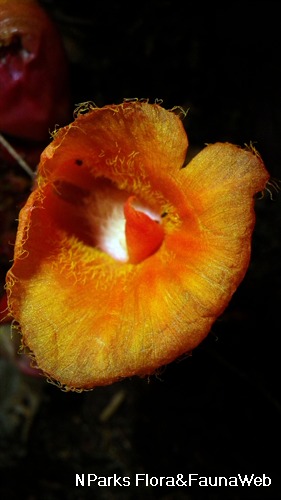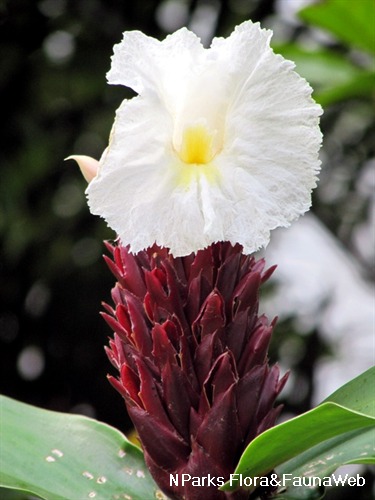
Back
Cheilocostus speciosus (J.Koenig) C.D.Specht
| Family Name: | Costaceae |
| Synonyms: | Costus speciosus (Koenig) Smith, Banksea speciosa J.Koenig, Hellenia speciosa (J.Koenig) S.R.Dutta |
| Common Name: | Crepe Ginger, Setawar Tawar, Spiral Flag, Cane Reed, Malay Ginger, Wild Ginger, Spiral Ginger, White Costus, 闭鞘姜 |
Cheilocostus speciosus, or commonly known as Crepe Ginger, is a rhizomatous herbaceous plant that is native to Singapore. It has long slender stems and can grow up to 3 m tall. Its leaves are oblong to lance-shaped, arranged spirally along the reddish slender stems. The flowering spike is dark red, and the white funnel-like flowers emerge from between the bracts. Its flowers attract biodiversity, such as carpenter bees and sunbirds.
Name
Classifications and Characteristics
| Plant Division | Angiosperms (Flowering Seed Plants) (Monocotyledon) |
|---|---|
| Plant Growth Form | Herbaceous Plant |
| Lifespan (in Singapore) | Perennial |
| Mode of Nutrition | Autotrophic |
| Maximum Height | 3 m |
Biogeography
| Native Distribution | Tropical & Subtropical Asia to Northeastern Queensland |
|---|---|
| Native Habitat | Terrestrial (Primary Rainforest, Secondary Rainforest, Disturbed Area / Open Ground) |
| Preferred Climate Zone | Tropical |
| Local Conservation Status | Native to Singapore (Critically Endangered (CR)) |
Description and Ethnobotany
| Growth Form | It is a large rhizomatous perennial herbaceous plant, with stems up to 3 m tall. |
|---|---|
| Foliage | Its leaves are lance-shaped to oblong, reaching up to 15 - 20 cm in length with a velvety surface. The foliage is arranged spirally along the long, slender stems. |
| Stems | It has an underground rhizome (thick, horizontal modified stems) that produces slender aboveground stems. The stems are reddish, slightly woody at the base. |
| Flowers | The inflorescence is a spike that reaches a height of 12-15 cm, with dark red bracts. The flowers are funnel-shaped, measuring up to 6 - 8 cm in width. The most prominent part of the flower is the frilly, crepe-like labellum or lip, which is a fused pair of staminodes (sterile stamens). A single petaloid stamen is present. The actual petals are small, white and reach up to 5.5 - 6 cm long. The sepals are reddish, about 2.5 cm long and fused at the base, ending in three narrow lobes. The lip is prominently white with a yellow throat. |
| Fruit | The fruit is a red, woody capsule, measuring up to 1.5 cm in diameter. Each contains numerous black glossy seeds which split upon maturity. |
| Habitat | It grows in damp open places, and is commonly found in lowland forest margins. |
| Associated Fauna | In Singapore, the flowers are visited by carpenter bees, butterflies, and sunbirds. |
| Cultivation | It thrives in partial shade, growing in moist, fertile soils. It can be propagated by seeds, division, or stem cuttings. |
| Etymology | The genus Cheilocostus is derived from the combination of the Greek term, cheilo "lip" and the genus Costus, alluding to the prominent lip or labellum of the flowers. The specific epithet speciosus means "showy" in Latin. |
| Ethnobotanical Uses | Edible Plant Parts : Edible Storage Organs Food (Fruit or Vegetable): Parts of the plant are consumed in rural communities of South East Asia and India. In Sarawak, young tender shoots are stir-fried with anchovies and fermented shrimp paste known as Belachan. Flowers are edible, often used in salads or added as garnish, rhizomes are cooked in curries or used to make syrups. One report states that the rhizomes are bitter and astringent. |
Landscaping Features
| Landscaping | It is suitable as an ornamental plant for borders or as a low screen. |
|---|---|
| Desirable Plant Features | Ornamental Flowers, Ornamental Foliage |
| Landscape Uses | General, Suitable for Roadsides, Parks & Gardens, Small Gardens, Hedge / Screening, Flowerbed / Border |
Fauna, Pollination and Dispersal
| Fauna Pollination Dispersal Associated Fauna | Bird-Attracting, Butterfly Host Plant |
|---|---|
| Pollination Method(s) | Biotic (Fauna) (Insects (Bee), Vertebrates (Bird)) |
| Seed or Spore Dispersal | Biotic (Fauna) |
Plant Care and Propagation
| Light Preference | Semi-Shade, Full Sun |
|---|---|
| Water Preference | Lots of Water, Moderate Water |
| Plant Growth Rate | Fast |
| Rootzone Tolerance | Moist Soils, Waterlogged Soils (Drains Site), Fertile Loamy Soils, Easy to Grow |
| Pest(s) | Chewing Insects |
| Propagation Method | Seed, Stem Cutting, Division, Aerial Plantlet |
Foliar
| Foliage Retention | Evergreen |
|---|---|
| Mature Foliage Colour(s) | Green |
| Mature Foliage Texture(s) | Velvety / Furry / Tomentose |
| Foliar Type | Simple / Unifoliate |
| Foliar Arrangement Along Stem | Spiral |
| Foliar Attachment to Stem | Petiolate |
| Foliar Shape(s) | Non-Palm Foliage (Lanceolate, Oblong) |
| Foliar Venation | Pinnate / Net |
| Foliar Margin | Entire |
| Foliar Apex - Tip | Acute |
| Foliar Base | Cuneate, Rounded / Obtuse |
Non - Foliar and Storage
| Stem Type & Modification | Pseudostem |
|---|---|
| Root Type | Underground (Fibrous Root) |
| Specialised Storage Organ(s) | Underground (Rhizome) |
Floral (Angiosperm)
| Flower & Plant Sexuality | Bisexual Flowers , Bisexual Flowers |
| Flower Colour(s) | White, Red, Yellow / Golden |
|---|
| Flower Texture(s) | Smooth, Thin |
| Flower Grouping | Cluster / Inflorescence |
| Flower Location | Terminal |
| Individual Flower Shape | Funnelform / Funnel-shaped |
| Inflorescence Type | Spike |
| Flowering Habit | Polycarpic |
Fruit, Seed and Spore
| Mature Fruit Colour(s) | Brown, Red |
|---|---|
| Fruit Classification | Simple Fruit |
| Fruit Type | Dehiscent Dry Fruit , Capsule |
References
| References | Royal Botanic Gardens, Kew (continuously updated). Plants of the World Online | Kew Science. https://powo.science.kew.org/taxon/urn:lsid:ipni.org:names:77074291-1. Accessed 04 January 2022. Singh, N (2011). Wild Edible Plant: A Potential source of nutraceutials. International Journal of Pharma Sciences and Research (IJPSR), vol. 2(12), pp. 216-225. Wu, Z.Y. & Raven, P.H. (2000). Costaceae. Flora of China (Flagellariaceae through Marantaceae), Vol. 24, pp. 320 - 321. Science Press, Beijing, and Missouri Botanical Garden Press, St. Louis. |
|---|
Image Repository
Others
| Master ID | 574 |
|---|---|
| Species ID | 1869 |
| Flora Disclaimer | The information in this website has been compiled from reliable sources, such as reference works on medicinal plants. It is not a substitute for medical advice or treatment and NParks does not purport to provide any medical advice. Readers should always consult his/her physician before using or consuming a plant for medicinal purposes. |


